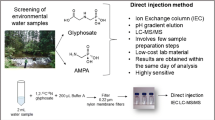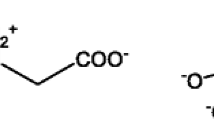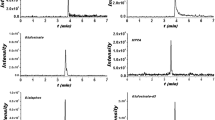Abstract
Glyphosate is currently the most widely used herbicide in the world; however, the zwitterionic and highly polar properties of glyphosate make current pesticide analysis methods unsuitable for its trace analysis in natural waters. Additionally, current glyphosate analysis methods do not account for waters of varying hardness, which is vital as glyphosate can complex with cationic species such as Ca2+ and Mg2+ in the environment. We detail here a robust LC-MS/MS method for the quantitation of glyphosate and its primary transformation product aminomethylphosphonic acid (AMPA) in environmental waters of varying water hardness. Chromatographic separation was achieved with a reversed-phase and weak anion-exchange mixed-mode column. We found that the addition of EDTA into hard water samples increases the response of both glyphosate and AMPA in the mass spectrometer. Limits of detection of 0.23 and 0.30 μg L−1 for glyphosate and AMPA in EDTA-amended hard water were achieved, respectively. We have demonstrated that the accuracy of the method was consistent over a wide range of water hardness levels up to a maximum of ~340 mg mL−1 CaCO3 hardness. We validated the method using matrix fortification of uncontaminated environmental samples from US river water. We then demonstrated that the method was successful at quantifying glyphosate and AMPA across surface and drinking water samples of varying water hardness from North Carolina and Sri Lanka. Measured concentrations of glyphosate and AMPA ranged from 1.6 to 13 μg L−1 and 0.50 to 2.5 μg L−1, respectively. This study represents a significant increase in sensitivity for LC-MS/MS analysis of glyphosate in hard water systems.

Graphical abstract






Similar content being viewed by others
Data availability
Raw data of analyses is available upon request by contacting the corresponding author.
References
Baylis AD. Why glyphosate is a global herbicide: strengths, weaknesses and prospects. Pest Manag Sci. 2000;56(4):299–308.
Jayasumana C, Gunatilake S, Senanayake P. Glyphosate, hard water and nephrotoxic metals: are they the culprits behind the epidemic of chronic kidney disease of unknown etiology in Sri Lanka? Int J Environ Res Public Health. 2014;11(2):2125–47.
Janke D. P. C. Kearney and D. D. Kaufman (Editors), Herbicides – chemistry, degradation, and mode of action, Volume 3. XIII + 403 S. New York–Basel 1988. Marcel Dekker Inc. ISBN: 0-8247-7804-9. J Basic Microbiol. 1989;29(10):718.
Szekacs A, Darvas B. Forty years with glyphosate. Herbicides—Properties, Synthesis and Control of Weeds. 2012. pp. 247–284.
Duke SO, Powles SB. Glyphosate: a once-in-a-century herbicide. Pest Manag Sci. 2008;64(4):319–25.
Sviridov AV, Shushkova TV, Ermakova IT, Ivanova E, Epiktetov DO, Leontievsky AA. Microbial degradation of glyphosate herbicides (review). Appl Biochem Micro. 2015;51:188–95.
Dick RE, Quinn JP. Glyphosate-degrading isolates from environmental samples: occurrence and pathways of degradation. Appl Microbiol Biotechnol. 1995;43:545–50.
Jacob GS, Garbow JR, Hallas LE, Kimack NM, Kishore GM. Metabloism of glyphosate in Pseudomonas sp. Strain LBr. Appl Environ Microbiol. 1988;54:2953–8.
Lerbs W, Stock M, Parthier B. Physiological aspects of glyphosate degradation in Alcaligenes spec. strain GL. Arch Microbiol. 1990;153:146–50.
Balthazor TM, Hallas LE. Glyphosate-degrading microorganisms from industrial activated sludge. Appl Environ Microbiol. 1986;51:432–4.
Rueppel ML, Brightwell BB, Schaefer J, Marvel JS. Metabolism and degradation of glyphosate in soil and water. J Agric Food Chem. 1977;25:517–28.
Madsen HEL, Christensen HH, Gottlieb-Petersen C. Stability constants of copper(II), zinc, manganese(II), calcium, and magnesium complexes of N-(Phosphonomethyl)glycine (glyphosate). Acta Chemica Scandinavica A. 1978;32:79–83.
Subramaniam V, Hoggard PE. Metal complexes of glyphosate. J Agric Food Chem. 1988;36:1326–9.
Tsui MTK, Wang W, Chu LM. Influence of glyphosate and its formulation (Roundup®) on the toxicity and bioavailability of metals to Ceriodaphnia dubia. Environ Pollut. 2005;138:59–68.
Williams GM, Kroes R, Munro IC. Safety evaluation and risk assessment of the herbicide Roundup and its active ingredient, glyphosate, for humans. Regul Toxicol Pharmacol. 2000;31(2):177–65.
Benbrook, CM. How did the US EPA and IARC reach diametrically opposed conclusions on the genotoxicity of glyphosate-based herbicides? Environ Sci Eur. 2019;31(1).
IARC (2017) IARC Monographs on the evaluation of carcinogenic risks to humans—volume 112: some organophosphate insecticides and herbicides. https://monographs.iarc.fr/wp-content/uploads/2018/07/mono112.pdf. Accessed 6 April 2020.
Robinson C. Teratogenic effects of glyphosate-based herbicides: divergence of regulatory decisions from scientific evidence. J Anal Toxicol. 2012; 01(S4).
Menéndez-Helman RJ, Ferreyroa GV, dos Santos AM, Salibián A. Glyphosate as an acetylcholinesterase inhibitor in Cnesterodon decemmaculatus. Bull Environ Contam Toxicol. 2012;88(1):6–9.
Hued AC, Oberhofer S, de los Ángeles Bistoni M. Exposure to a commercial glyphosate formulation (Roundup®) alters normal gill and liver histology and affects male sexual activity of Jenynsia multidentata (Anablepidae, Cyprinodontiformes). Arch Environ Contam Toxicol. 2012;62:107–17.
Seneff S, Nigh GL. Glyphosate and anenccephaly: death by a thousand cuts. J Neurol Neurobiol. 2017;3(2):1–15.
Gill JPK, Sethi N, Mohan A, Datta S, Girdhar M. Glyphosate toxicity for animals. Environ Chem Lett. 2017;16(2):401–26.
Babich R, Ulrich JC, Ekanayake D, Massarsky A, De Silva PMCS, Manage P, et al. Kidney developmental effects of metal-herbicide mixtures: implications for chronic kidney disease of unknown etiology. Environ Int. 2020;144:1–15.
Jayasumana C, Paranagama P, Agampodi S, Wijeardane C, Gunatilake S, Siribaddana S. Drinking well water and occupational exposure to herbicides is associated with chronic kidney disease, in Padavi-Sripura, Sri Lanka. Environ Health. 2015;14:1–10.
Aguilar DJ, Madero M. Other potential ckd hotspots in the world: the cases of Mexico and the United States. Semin Nephrol. 2019;39(3):300–7.
Kulathunga MRDL, Ayanka Wijayawardena MA, Naidu R, Wijeratne AW. Chronic kidney disease of unknown aetiology in Sri Lanka and the exposure to environmental chemicals: a review of literature. Environ Geochem Health. 2019;41(5):2329–38.
Levine KE, Redmon JH, Elledge MF, Wanigasuriya KP, Smith K, Munoz B, et al. Quest to identify geochemical risk factors associated with chronic kidney disease of unknown etiology (CKDu) in an endemic region of Sri Lanka-a multimedia laboratory analysis of biological, food, and environmental samples. Environ Monit Assess. 2016;188(10):548.
Ananda Jayalal TB, Jayaruwan Bandara T, Mahawithanage STC, Wansapala MAJ, Galappaththi SPL. A quantitative analysis of chronic exposure of selected heavy metals in a model diet in a CKD hotspot in Sri Lanka. BMC Nephrol. 2019;20(1):208.
Wimalawansa SJ. The role of ions, heavy metals, fluoride, and agrochemicals: critical evaluation of potential aetiological factors of chronic kidney disease of multifactorial origin (CKDmfo/CKDu) and recommendations for its eradication. Environ Geochem Health. 2016;38(3):639–78.
Gunatilake S, Seneff S, Orlando L. Glyphosate’s synergistic toxicity in combination with other factors as a cause of chronic kidney disease of unknown origin. Int J Environ Res Public Health. 2019; 16(15).
Stalikas CD, Konidari CN. Analytical methods to determine phosphonic and amino acid group-contaiinng pesticides. J Chromatogr A. 2001;907:1–19.
Kudzin ZH, Gralak DK, Drabowicz J, Luczak J. Novel approach for the simultaneous analysis of glyphosate and its metabolites. J Chromatogr A. 2002;947:129–41.
Börjesson E, Torstensson L. New methods for determination of glyphosate and (aminomethyl)phosphonic acid in water and soil. J Chromatogr A. 2000;886:207–16.
Roseboom H, Berkhoff CJ. Determination of the herbicide glyphosate and its major metabolite aminophosphonic acid by high-performance liquid chromatography after fluorescence labeling. Anal Chim Acta. 1982;135:373–7.
Patsias J, Papadopoulou A, Papadopoulou-Mourkidou E. Automated trace level determination of glyphosate and aminomethylphosphonic acid in water by on-line anion-exchange solid-phase extraction followed by cation-exchange liquid chromatography and post-column derivatization. J Chromatogr A. 2001;932:83–90.
Grey L, Nguyen B, Yang P. Liquid chromatography/electrospray ionization/isotopic dilution mass spectrometry analysis of n-(phosphonomethyl) glycine and mass spectrometry analysis of aminomethyl phosphonic acid in environmental water and vegetation matrixes. J AOAC. 2001;84:1770–80.
Cikalo MG, Goodall DM, Matthews W. Analysis of glyphosate using capillary electrophoresis with indirect detection. J Chromatogr A. 1996;745:189–200.
Molina M, Silva M. Simultaneous determination of phosphorus-containing amino acid-herbicides by nonionic surfactant micellar electrokinetic chromatography with laser-induced fluorescence detection. Electrophoresis. 2001;22:1175–81.
Chang SY, Liao C. Analysis of glyphosate, glufosinate and aminomethylphosphonic acid by capillary electrophoresis with indirect fluorescence detection. J Chromatogr A. 2002;959(1–2):309–15.
Zhu Y, Zhang F, Tong C, Liu W. Determination of glyphosate by ion chromatography. J Chromatogr A. 1999;850:297–301.
Bauer K, Knepper TP, Maes A, Schatz V, Voihsel M. Analysis of polar organic micropollutants in water with ion chromatography-electrospray mass spectrometry. J Chromatogr A. 1999;837:117–28.
Qiu HM, Geng JJ, Han C, Ren H-Q. Determination of phosphite, phosphate, glyphosate and aminomethylphosphonic acid by two-dimensional ion chromatography system coupled with capillary ion chromatography. Chin J Anal Chem. 2013;41(12):1910–4.
Hao C, Morse D, Morra F, Zhao X, Yang P, Nunn B. Direct aqueous determination of glyphosate and related compounds by liquid chromatography/tandem mass spectrometry using reversed-phase and weak anion-exchange mixed-mode column. J Chromatogr A. 2011;1218(33):5638–43.
Bo P, Lei J, Bingjie W, Yong L. Determination of glyphosate and its main metabolite aminomethyl phosphinc acid in water by two methods: direct injection and pre-column derivatization. Nanjing Nongye Daxue Xuebo. 2020;43:79–87.
Methods for measuring the acute toxicity of effluents and receiving waters to freshwater and marine organisms. Environmental Protection Agency. US Government Printing Office: Washington, DC, 2015.
Myint KT, Uehara T, Aoshima K, Oda Y. Polar anionic metabolome analysis by Nano-LC/MS with a metal chelating agent. Anal Chem. 2009;81:7766–72.
Armbruster DA, Tillman MD, Hubbs LM. Limit of detection (lqd)/limit of quantitation (loq): comparison of the empirical and the statistical methods exemplified with gc-ms assays of abused drugs. Clin Chem. 1994;40(7):1233–8.
Lawson GM. Defining limit of detection and limit of quantitation as applied to drug of abuse testing: striving for a consensus. Clin Chem. 1994;40(7):1218–9.
Crawford JK. Water quality of North Carolina streams: water quality of North Carolina streams water-quality characteristics for selected sites on the cape fear river, North Carolina, 1955-30 variability, loads, and trends of selected constituents. United States Geological Survey, 1985;1–51.
Battaglin WA, Thurman EM, Kolpin DW, Scribner EA, Sandstrom MW, Kuivila KM. Work plan for determining the occurrence of glyphosate, its transformation product AMPA, other herbicide compounds, and antibiotics in midwestern United States streams, 2002: U.S. Geological Survey Open-File Report 03–69. 2003;18
Lee EA, Strahan AP, Thurman EM. Methods of analysis by the U.S. Geological Survey Organic Geochemistry Research Group - determination of glyphosate, aminomethylphosphonic acid, and glufosinate in water using online solid-phase extraction and high-performance liquid chromatography/mass spectrometry: U.S. Geological Survey Open-File Report 01–454. 2002;13.
US Environmental Protection Agency. National primary drinking water regulations. https://www.epa.gov/ground-water-and-drinking-water/national-primary-drinking-water-regulations. Accessed 28 Nov 2020.
Environmental Working Group. EWG’s tap water database: contaminants in your water. https://www.ewg.org/tapwater. Accessed 28 Nov 2020.
von Mérey G, Manson PS, Mehrsheikh A, Sutton P, Levine SL. Glyphosate and aminomethylphosphonic acid chronic risk assessment for soil biota. Environ Toxicol Chem. 2016;35(11):2742–52.
Code availability
Not applicable.
Funding
Funding support was provided from the National Institutes of Health through the Duke University Superfund Research Center (P42 ES010356) and the Duke Environmental Analysis Laboratory (U2C ES030851).
Author information
Authors and Affiliations
Corresponding author
Ethics declarations
Competing interests
The authors declare no competing interest.
Additional information
Publisher’s note
Springer Nature remains neutral with regard to jurisdictional claims in published maps and institutional affiliations.
Supplementary information
ESM 1
(PDF 1049 kb)
Rights and permissions
About this article
Cite this article
Ulrich, J.C., Ferguson, P.L. Development of a sensitive direct injection LC-MS/MS method for the detection of glyphosate and aminomethylphosphonic acid (AMPA) in hard waters. Anal Bioanal Chem 413, 3763–3774 (2021). https://doi.org/10.1007/s00216-021-03324-5
Received:
Revised:
Accepted:
Published:
Issue Date:
DOI: https://doi.org/10.1007/s00216-021-03324-5




